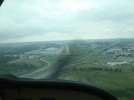I think what's more important is his knowledge of the world of drone regulations. The main point of his video is to question why the drone pilot got off so easily, fined only Cdn$1000 as an individual, rather than the larger fine for a corporation, and for only a single offence that would surely have been dealt with much more severely if it had involved a member of the general public, rather than the police.
Correct, the Transportation Safety Board does the investigation and publishes the report without assessing blame. It is Transport Canada who writes the regulations and enforces them with appropriate fines assessed. The fine was never contested in court.
Neither the student pilot nor instructor were fined for their failure to "see-and-avoid" the collision. That makes perfect sense. What makes no sense at all is that their see-and-avoid failure was listed as the very first item in the TSB's report as to cause and contributing factors leading to the collision.
As Don points out, much larger fines have been imposed for much less severe situations. All of the regulations are intended to avoid presenting a hazard to manned aviation or to people and property on the ground. And here we have an actual collision caused by multiple infractions over several regulations, the result of which could only have been worse if it actually killed someone. And yet the penalty was relatively insignificant.
What makes you think the student was "under the hood" during final approach to landing?
Here's the TSB report:
www.tsb.gc.ca/eng/rapports-reports/aviation/2021/a21o0069/a21o0069.pdf












